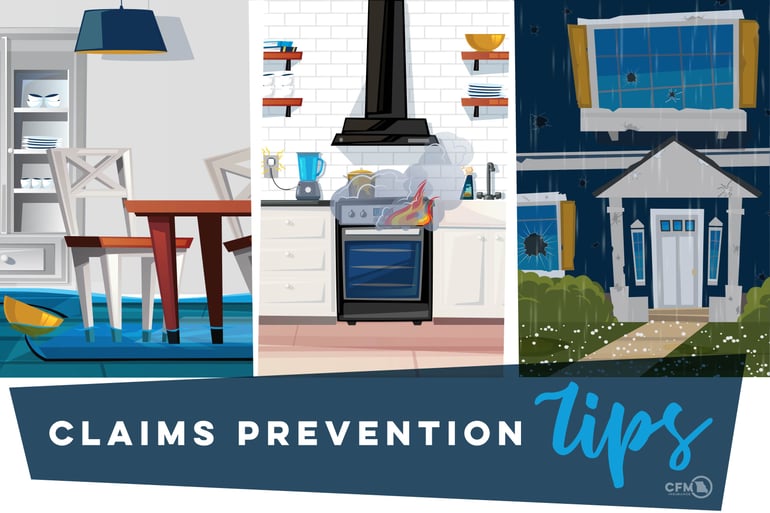
Much like parents try to prevent scrapes and bruises on their children, homeowners do the same when it comes to their property. Nobody wants to see a big, blaring ouchie on their home, especially the kind that isn't budget-friendly to fix, but we all know by now that life (and Mother Nature) is highly unpredictable.
While we may not be able to control every weather event or issue to pop up at home base, we can control how well we plan for them. Keeping the three most common homeowners insurance claims in mind, let's jump into the most effective preventative measures every property owner can take to minimize or altogether avoid the damage of an unwanted what if.
But first...
Did you know? Smart home devices designed to alert you in real-time about some of the following claim scenarios below help lessen your potential damage significantly (we're talking to you, water leaks and home fires). Consider investing in wifi-enabled leak detecting devices or smoke detector batteries to keep your home safe and sound. Plus, when you install these products in your home, you'll see a discount on your CFM policy. We'll talk more about that perk later.
#1 Most Common Homeowner Claim: Wind/Hail Damage
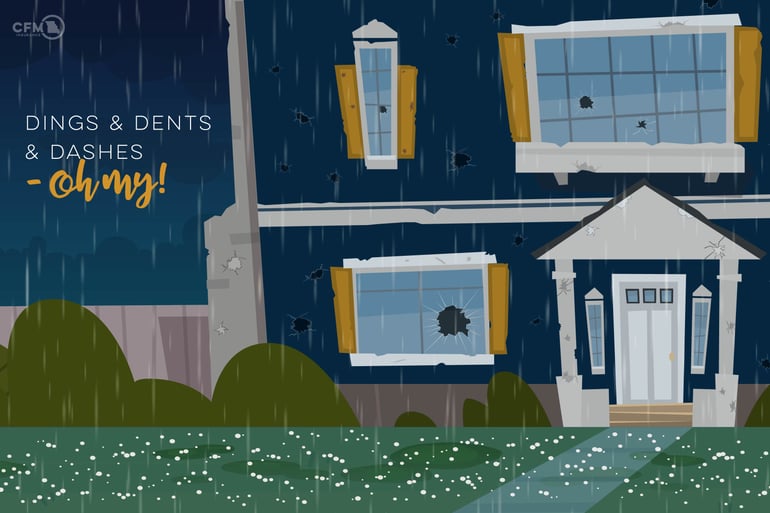
Dings and dents and dashes all have one thing in common - they aren't very pretty - especially when they make an appearance on your property after a hailstorm.
Because we live in Missouri - which never fails to see an active storm season - it's difficult to avoid the possibility of wind and hail damage at home. According to NOAA's Severe Storm Database, over the past five years, claims related to wind and hail damage on a national basis accounted for almost 40% of all insured losses, averaging approximately $15 billion annually; and growing each year.
Did you know? The largest recorded hailstone in U.S. history fell on July 23, 2010, in Vivian, South Dakota, measuring 8 inches in diameter and weighing a whopping 1.94 pounds. The prized, jagged stone is now on ice at the National Center of Atmospheric Research in Boulder, Colorado.
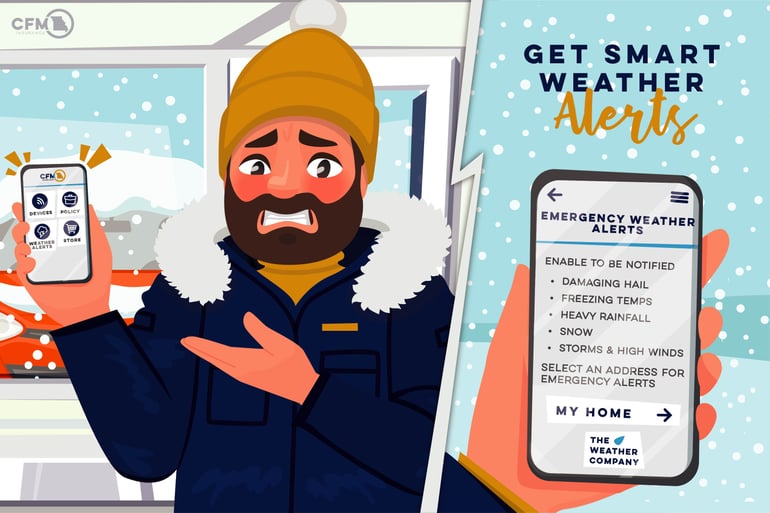 Keep your fingers crossed that a storm packing two-pound hailstones doesn't roll through Missouri any time soon. Better yet, instead of relying on luck, you could depend on up-to-the-minute weather alerts sent straight to your smartphone through an app. Click here to see this year's most accurate, user-friendly weather apps.
Keep your fingers crossed that a storm packing two-pound hailstones doesn't roll through Missouri any time soon. Better yet, instead of relying on luck, you could depend on up-to-the-minute weather alerts sent straight to your smartphone through an app. Click here to see this year's most accurate, user-friendly weather apps.
Now, let's look at how to best prepare for a typical Midwest storm.
Preventative Measures
1. Reinforce your garage door.
When winds are strong enough, they can completely blow off even the most sturdy garage door and consequently damage the contents inside your garage. Take time every year or two to have your garage door professionally inspected before storm season's arrival, that way you know for sure it has the ability to withstand strong winds. For DIY tips on how to reinforce your garage door, check out this how-to video from Today's Homeowner.
2. Consider adding shutters to your windows and doors.
If you live in an area prone to damaging winds every storm season, take a note from coast dwellers and consider installing steel or aluminum storm shutters on your windows, French doors, and sliding glass doors for added protection. If they can keep glass safe from hurricane force winds, they're probably a good match for a Midwest storm season. When you hear that a storm is coming, you can quickly close the shutters to prevent flying debris from breaking glass - saving you a mess and costly repairs.
3. Check to make sure your shingles are in good condition and secure.
When high winds and hail come through your neighborhood, they can blow shingles from your roof and damage the felt and wood sheeting beneath, making your home vulnerable to rain and unwanted roof leaks. Take a look at your roof every season if you can, to investigate the condition of your shingles. Understanding what true hail damage looks like will help, so be sure to check out our blog for real-life examples. If it looks like you may have wind or hail damage to your roof, call your insurance company right away to have an experienced claim adjuster assess the damage.
4. Properly fasten down metal siding and roofing.
While metal siding and roofing are highly durable, when strong enough winds blow through, they can tear away entire metal panels from your home. If you have metal building materials protecting the exterior of your home, frequently check to make sure it is properly fastened down. Metal roofing and siding should be secured to the frame of your home with exposed fasteners, such as screws and bolts, or with concealed clips. All metal siding edges, such as those along the corners of your home, should be covered by a metal cap or molding so the wind can’t work its way beneath the siding.
5. Regularly trim trees and shrubs that are close to your home.
When you have overgrown trees and shrubs, your home is more susceptible to damage during a wind or hailstorm. Hail, accompanied by high-speed winds, can take down dead limbs and sling them onto your roof and siding causing damage. To avoid this, regularly trim tree branches and shrubs that sit close to your home, especially near your windows and roof. If you have large, mature trees on your property, make sure they sit far enough away from your home to prevent damage if they were to fall. If they're dangerously close, call a local, trusted tree trimming company to help determine your options, including the cost of removal.
6. Properly anchor detached sheds/outbuildings, and patio furniture.
Anchor detached storage sheds and outbuildings with a permanent foundation or straps and ground anchors to prevent them from blowing away and damaging your home/personal property during a windstorm. Secure other potential airborne objects, like your barbeque grill, play equipment (trampoline, pool, swingset) and outdoor furniture, by bolting them to their surface. Use ground anchors with durable metal cables and chains. If you can, add an impact-resistant cover to your deck/patio to protect furniture from ugly hail damage.
7. Keep your gutters clear of debris.
Remove leaves and other debris from your gutters before a storm, as they can block rain from flowing out and away from your home. When hail hits your gutters, it can pile up if it has no clear path out, leading to potential water damage in your home. It's also essential to make sure your gutters are properly secured. Weak, loose, or weathered gutters need to be repaired/replaced immediately so a windstorm can't pull them from your home. If you've ever considered adding a gutter guard to your system, check out these recommendations from the Family Handyman.
#2 Most Common Homeowner Claim: Water Damage
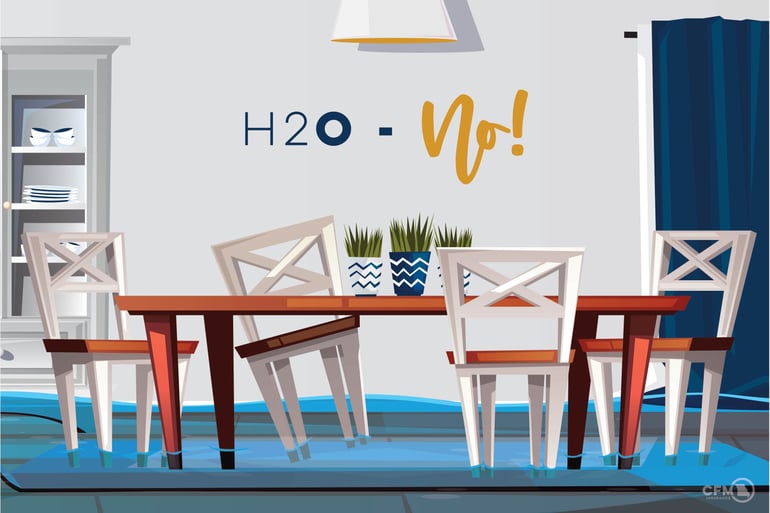
Don't catch yourself saying "H2O-No!" when you discover extensive (and expensive) water damage in your home.
According to data collected by Water Damage Defense, around 40% of U.S. homeowners claim to have suffered losses from water damage, with an average cost of repair nearing $7,000. Water damage at home can occur from natural events - excessive rain or snowmelt - and non-natural events - pipes freezing, bursting, or leaking. By comparison, more water damage is caused non-weather events like plumbing issues.
Did you know? Water damage is classified into three categories: Clean Water, Grey Water, and Black Water. Clean water (from a sink overflow) is uncontaminated at its source and does not pose a threat if people are exposed to it. Grey water (discharge from a dishwasher) could contain some contaminants and might cause discomfort or illness to people exposed to it. Black water (sewage spills or flood water) is contaminated, which could cause serious illness or even death to people exposed to it.
It's important to investigate and fix a small plumbing issue right away, so it doesn't become a big problem, down the road. When you ignore moisture damage caused by a leak or postpone making the necessary repairs to fix it, be prepared to experience health hazards caused from mold and mildew, dry rot, and even structural damage to your home. Homeowners insurance is designed to provide coverage for damage that is sudden and accidental - not damage that is a result of lack of maintenance - so be sure you're taking these steps to prevent water damage at your property.
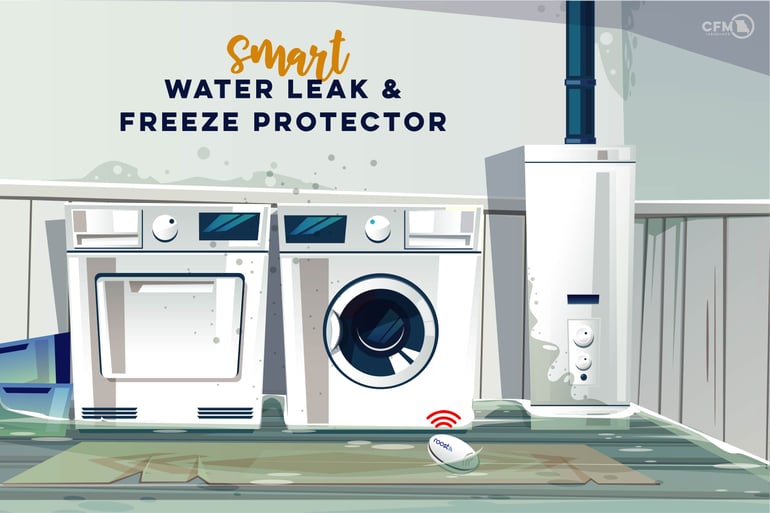
The most efficient, easy way to monitor for potential water hazards at your home is by utilizing leak detectors. Home Telematics like leak detectors provide early detection of common home problems like water leaks, abnormal humidity levels, and freezing pipes. These small but mighty wifi-enabled devices deliver critical benefits to homeowners by working in conjunction with an app to detect small leaks before they become a huge (and expensive) headache. Check out your local hardware or technology store to explore the smart home devices available to you.
Preventative Measures: Outside
1. Disconnect your garden hose every winter.
When freezing temperatures are on the way, disconnect your garden hose from your outside spigot. Standing water in a hose can freeze back into the pipe and create an ice block capable of stopping water flow in your home or bursting the pipeline altogether, creating water damage to your walls, flooring, and foundation. For more tips on protecting your outside faucets in the winter, watch this helpful how-to video.
2. Clean your gutters to prevent ice dams.
Did we mention how important it is to clean your gutters regularly? Make it a priority to have your gutters cleaned at least twice a year so that you can avoid the headache of an ice dam in the winter. If gutters are clogged, standing water can cause damage to not only your gutters, but your roof, foundation, and interior of your home. And don’t forget to clean and secure downspouts so water can flow through, out, and away from your home's foundation.
3. Maintain your landscaping.
Full, mature shrubs look nice, but the larger they get, the more risk they pose to your home. When shrubs are planted and grown too close to your home, their roots can wrap around your pipes and crush them. Consider relocating older, large shrubs/landscaping away from utility pipes before they become a problem.
Preventative Measures: Inside
1. Get familiar with your water main.
Your home's main water shutoff valve is arguably the most important plumbing feature in your home because it supplies water to the entire property. Typically, your water main is located in the basement, near the front wall of the house, or even outside the house. Learn the location of your home's water main and shut it off when you leave for an extended amount of time or you fear you may have a frozen/cracked pipe. This simple, preventative measure will save you time and money if a small leak were to turn into a large one without your immediate knowledge.
2. Employ the use of leak-detecting devices.
It's always best to check and maintain your appliances on a routine basis for leaks, according to the manufacturer’s directions. But for even more added security, consider placing a Smart Water Leak & Freeze Detector near your water heater, sump pump, washing machine, dishwasher, or toilet. These handy devices help to prevent extensive damage and mold growth by alerting you through your smartphone when a change in moisture level is apparent.
3. Replace your appliance hoses regularly.
Old, brittle, or leaky washing machine, dishwasher, or ice maker hoses are among the most frequent causes of water loss for homeowners. Most appliance hoses are very affordable, so be sure to replace yours at the first sign of wear to avoid a mighty mess and expensive damage.
4. Check your water pressure.
If the water pressure to your home is set too high, pipes and hoses may fail under the pressure and cause your home to flood. Buy a water pressure gauge that measures in psi (pounds per square inch) at a local hardware store, attach it to an outside faucet, and turn the faucet to full force. The gauge will then deliver a reading of your home’s water pressure. Typical residential water systems are designed for water pressure of 40–70 psi, so if your home's water pressure exceeds that, you may want to install a pressure regulator, which are also found at most hardware stores.
5. Monitor your water bill.
If nothing else, trust your water bill to alert you of a leak in your home. If your usage jumps significantly from one month to the next without explanation, it's a sure sign that a hidden leak is happening. For example, toilets alone can waste up to 250 gallons of water a day when running continuously. Call a plumber if you can't determine the cause of your increased water bill - they can do the detective work for you.
#3 Most Common Homeowner Claim: Fire
 Don't let the heart of your home become a hotspot hub.
Don't let the heart of your home become a hotspot hub.
According to the NFPA, U.S. fire departments respond to an average of one home fire every 88 seconds, citing cooking as the leading cause of those home fires and home-fire injuries. Second to cooking mishaps, heating equipment is another leading cause of harm, as it is to blame for one in every five home-fire deaths.
Did you know? In just two minutes, a fire can become life-threatening. In five minutes, a residence can be engulfed in flames. The NFPA asked American households to estimate how long they thought they had to escape a fire and one-third thought they would have at least six minutes.
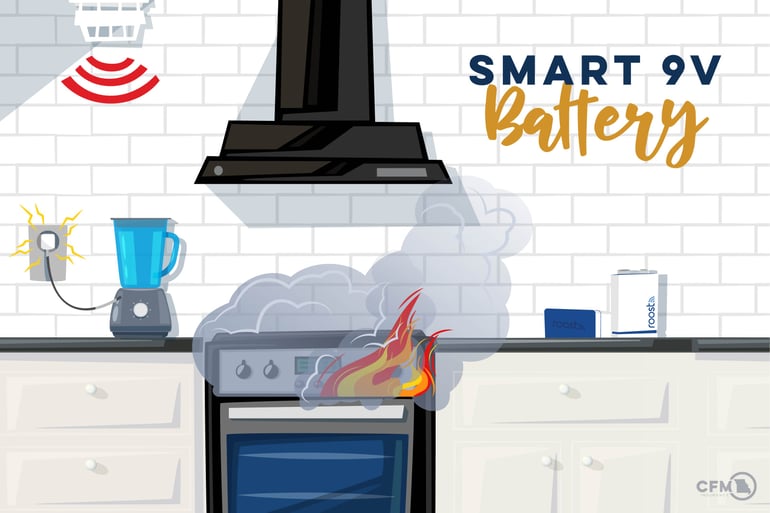
Be notified instantly of any fire threats in your home with smart batteries. A wifi-enabled 9V battery transforms existing CO and smoke alarms into a Smart Alarm. When an alarm sounds, you will be alerted instantly through an app. Many times, these devices have an impressive battery life - sometimes up to five years.
Whether you install a helpful smart battery in your smoke detector or not, there's no denying the narrow time frame for both you and your home's survival if a fire breaks out. Be sure to take all the necessary precautions below to prevent a fire from damaging or completely destroying your most valuable possessions.
Preventative Measures
1. Always have working smoke/carbon monoxide alarms.
Place working smoke and carbon monoxide detectors on every level of your home and inside each bedroom. Make sure all alarms are interconnected so that if one alarm is triggered, they all sound. Test each alarm monthly to make sure the batteries work, and replace batteries in battery-powered and hard-wired smoke alarms at least once a year (except non-replaceable 10-year lithium batteries). And never disable a smoke alarm while cooking – it can be a deadly mistake.
2. Keep fire extinguishers on all floors of your home.
Keep functioning fire extinguishers on all floors of your home in an easily accessible place. If you don't like the way the look, make them a part of your decor by placing them in a pretty and functional wooden cabinet like this one from Wayfair. Manufacturers say most extinguishers should work for 5 to 15 years, but you should check the pressure gauge monthly. If the needle on the gauge is in the green area, it’s functional. If it falls anywhere else, the extinguisher is unreliable and should be serviced or replaced. For an older model without a gauge, have it checked by a pro and see if they can service your fire extinguisher model annually.
3. Have a fire evacuation plan handy - and practice it.
Because every second counts in the event of a fire, it's crucial to not only plan your escape - but practice it, well. Create a thorough emergency evacuation plan with your family and make sure everyone knows a designated outside meeting place, a safe distance from the home. Immediate family members and guests alike should know your home address and be able to identify two ways out of every room so they are aware of their escape routes in the event of an emergency. And as you practice your evacuation plan, don't forget to educate your children on how to dial 9-1-1.
4. Designate an outdoor smoking area.
If smoking is allowed on your property, designate an outdoor smoking area that is well away from your home. Make sure your smoking area is on gravel, bare dirt, or a patio or walkway made from paving stones, concrete or bricks. You want to avoid having smokers on ground covers that may be flammable or could be damaged, such as wood chips, living ground covers, a wood deck or synthetic turf. Don't forget to provide a safe place to discard cigarette butts, like a deep, sturdy ashtray.
5. Keep electrical outlets free of multiple cords.
An overloaded power outlet can cause a tripped circuit breaker, increase your risk for electrocution, or start a fire. According to the NFPA, products that generate heat, such as hair dryers, space heaters, toasters or crock pots, should always be plugged directly into the electrical outlet. They simply pull too much power to safely use with a power strip or extension cord. If you do use a power strip for non-heat producing fixtures, make sure it has surge protection for added safety, the electrical cords plugged into it aren't frayed or damaged, and any flammable material, including pillows, sheets or clothes, are not covering them. To prevent overheating, they require adequate airflow.
6. Keep flammable objects far away from hot surfaces.
Keep your stovetop clear of anything that could catch fire, like towels, pot holders, or curtains. The same goes for space heaters. Keep space heaters on a hard, level surface at least 3 feet away from furniture, window treatments, bedding, clothing, or rugs. And always turn them off when you leave the room or home.
7. Consider installing an automatic fire sprinkler system.
Home fire sprinklers protect lives by keeping fires small, reducing the risk of death by 80% and reducing the risk of property loss by 70%. By minimizing the heat, flames, and smoke produced in a fire, fire sprinkler systems allow you more time to escape. To properly install an in-home sprinkler system, call your local, trusted contractor.
8. Practice fire safety on your vacation.
While this technically isn't a fire prevention tip for life at home, it's good for those who love to travel. Rentable properties are becoming more and more popular among vacationers. Before booking your Airbnb, message the owner and make sure they have proper safety precautions in place for the possibility of a fire during your stay. Rest assured, if a fire does occur at your vacation rental and your belongings become damaged or destroyed, your personal property coverage on your homeowners insurance policy will kick in. Personal property coverage follows you wherever you go.
Attention CFM Policyholders: Filing An Insurance Claim Is Easy With The CFM Policyholder App
Sometimes despite your best efforts to prevent an insurance claim from happening by using the prevention techniques above, certain circumstances leave you no choice but to file one. After all, that’s what your insurance is for - to be there for you when you really need it. At CFM, our goal is to make your claims process as stress-free and simplified as possible. So, we’re now offering you the convenience of reporting a claim on your phone through the Policyholder App. We’ve created a streamlined five-step claims process at your fingertips that allows you to upload claims photos, check on status updates, and contact your adjuster easily. Click here for a breakdown of how the app works and where you can download it.
One more thing...
The last (and probably most important) proactive tip we have is to make sure you fully understand your home insurance policy coverages before you ever need to file a claim. Get in touch with your local insurance agent annually to review your policy, go over any coverage changes, and determine new policy discounts you may qualify for.




Your Comments :